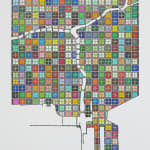Lordy Rodriguez: Code Switch
In his fifth solo exhibition at Hosfelt Gallery, Lordy Rodriguez presents new works on paper that utilize the map as a framework in which to experiment with unorthodox combinations of familiar visual languages from a variety of sources, including advertising, reality TV, fashion, gift-wrapping, and signature images associated with celebrity artists. With humor, craft, and adept analysis of popular culture, Rodriguez shrewdly subverts the fundamental purpose of design – to create something in the most beautiful and functional way – and the fundamental purpose of maps – to locate and transport ourselves in the world.
In linguistics, “code-switching” means mixing languages or patterns of speech in conversation. Rodriguez applies this concept to the visual languages of popular culture, using the vocabulary of cartography as a ‘grammatical backbone.’ In this process, he has developed his own lexicon and ‘signature style,’ while disrupting our conditioned expectations of the function and meaning of symbols and design.
Maps describe a place, and by extension an identity. Brand-name patterns and logos are also symbolic of identity, in terms of culture, class, and status. In Gangnam, America, Rodriguez remaps the country by ‘cultural capitols’ – i.e. entertainment districts in the US as defined by Wikipedia. In most cases, these were historically gay or ethnic neighborhoods, now branded and transformed, through appropriated, watered-down ‘culture’ from elsewhere, into centers of pop culture – essentially shopping and nightlife. America here is an ostentatiously elongated island floating in a Burberry sea.
The boundaries between ostensibly opposed cultural referents like mass-produced consumer goods and original, high-end art are increasingly blurred. Several works riff on motifs associated with luxury brands, like Michael Kors and Louis Vuitton, and celebrity artists Takashi Murakami and Damien Hirst. Like the instantly recognized Louis Vuitton monogram, Murakami’s mushrooms and Hirst’s dots have infiltrated global markets, reproduced on coveted products synonymous with wealth, taste and prestige.
Rodriguez began working with the vocabulary and concept of the map just as the digital revolution was propelling the shift from paper maps to map apps. The same technology is driving the rapid transformation of language and communication. The speed in which cultural memes are transferred almost overcomes the rate at which we can absorb them. Our vernacular has become a hodge-podge of cultural references, idioms, tropes, and entirely new words or new meanings for words. The work in Code Switch represents Rodriguez’s experiments in ‘code-switching’ the visual languages of popular culture in an ongoing exploration of real and virtual place and identity.
Lordy Rodriguez was born in the Philippines and raised in Texas and Louisiana. He received a BFA from the School of Visual Arts in New York and an MFA from Stanford University. In 2009 his work was the subject of solo exhibitions at the Austin Museum of Art in Texas and the Nevada Art Museum in Reno. Rodriguez teaches at UC Berkeley.









